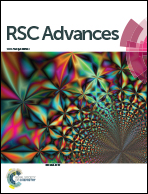Highly-efficient red-to-yellow/green upconversion sensitized by phthalocyanine palladium with high triplet energy-level†
Abstract
Soluble 3,7,11,15-tetra(tert-butyl)phthalocyanine palladium (TBPcPd) and 3,7,11,15-tetra(pentyloxy)phthalocyanine palladium (POPcPd) were synthesized and employed as sensitizers in expectation of achieving red-to-yellow/green upconversion (UC), doped with rubrene (Rub) and 9,10-bis(phenylethynyl)anthracene (BPEA), respectively. Under excitation of a 655 nm diode laser (∼1.5 W cm−2), a maximum red-to-green UC efficiency of 0.07% and a maximum red-to-yellow UC efficiency of 8.03% were obtained and the latter can drive a Si-photodiode to generate obvious photocurrent. The results showed that although a large triplet energy-level difference (ΔE = 3Esen. − 3Eanni.) of the sensitizer (3Esen.)/annihilator (3Eanni.) pair helps to improve the upconversion, the sensitizer/annihilator pair with a ΔE value less than zero still works. However, when the ΔE ≤ −0.05 eV, this bicomponent pair is not valid anymore. Thus, a comparison of the ΔE value can predict whether the sensitizer/annihilator pair is useful, which presents a quantitatively evaluated approach for exploring new-type upconversion systems for the first time.



 Please wait while we load your content...
Please wait while we load your content...